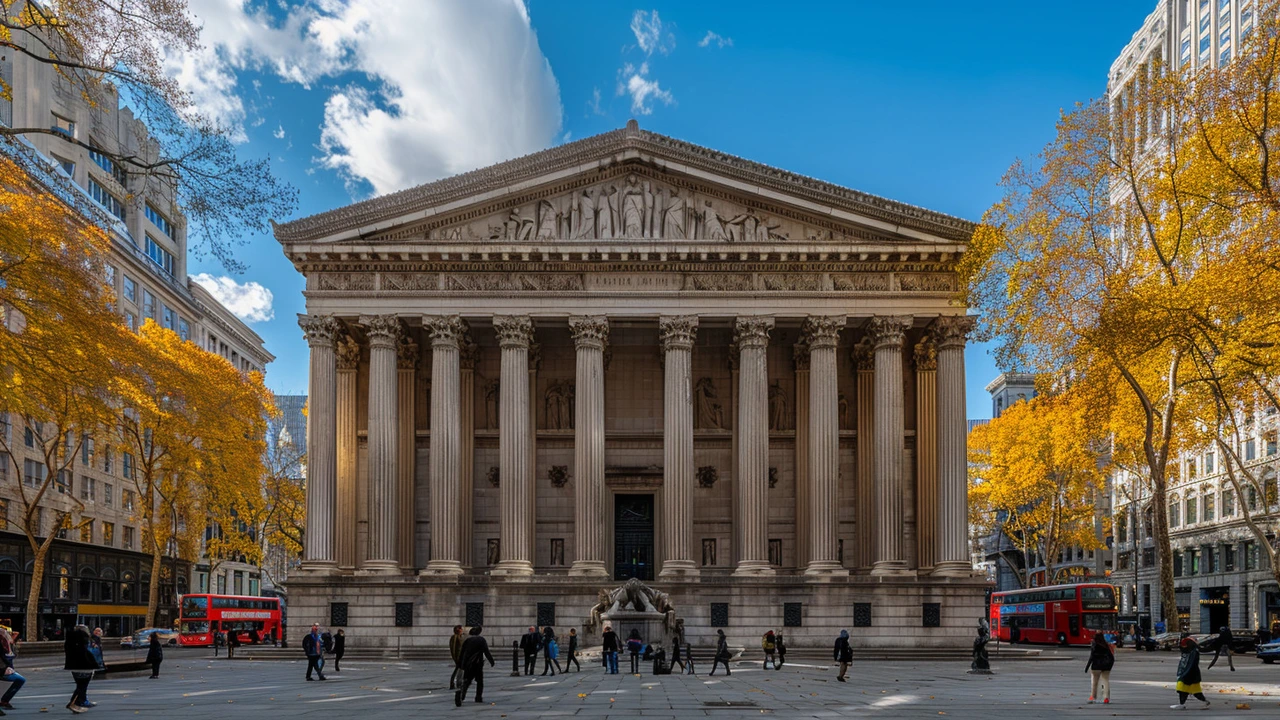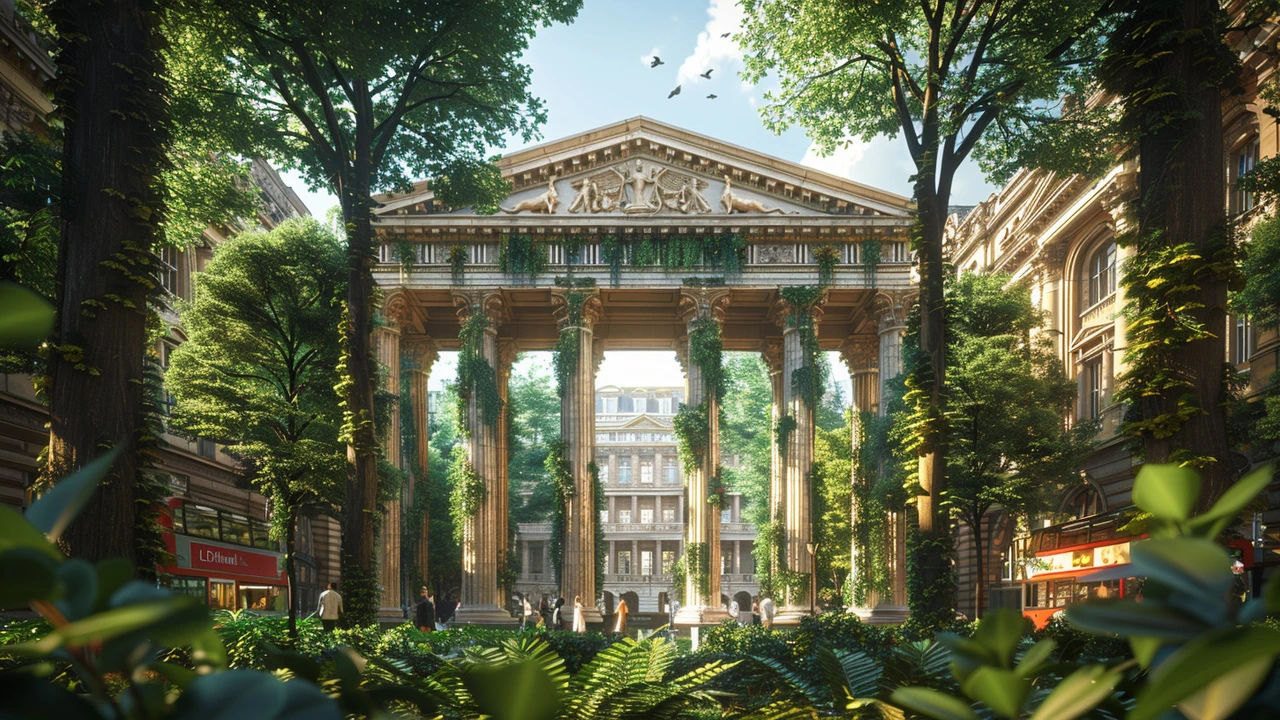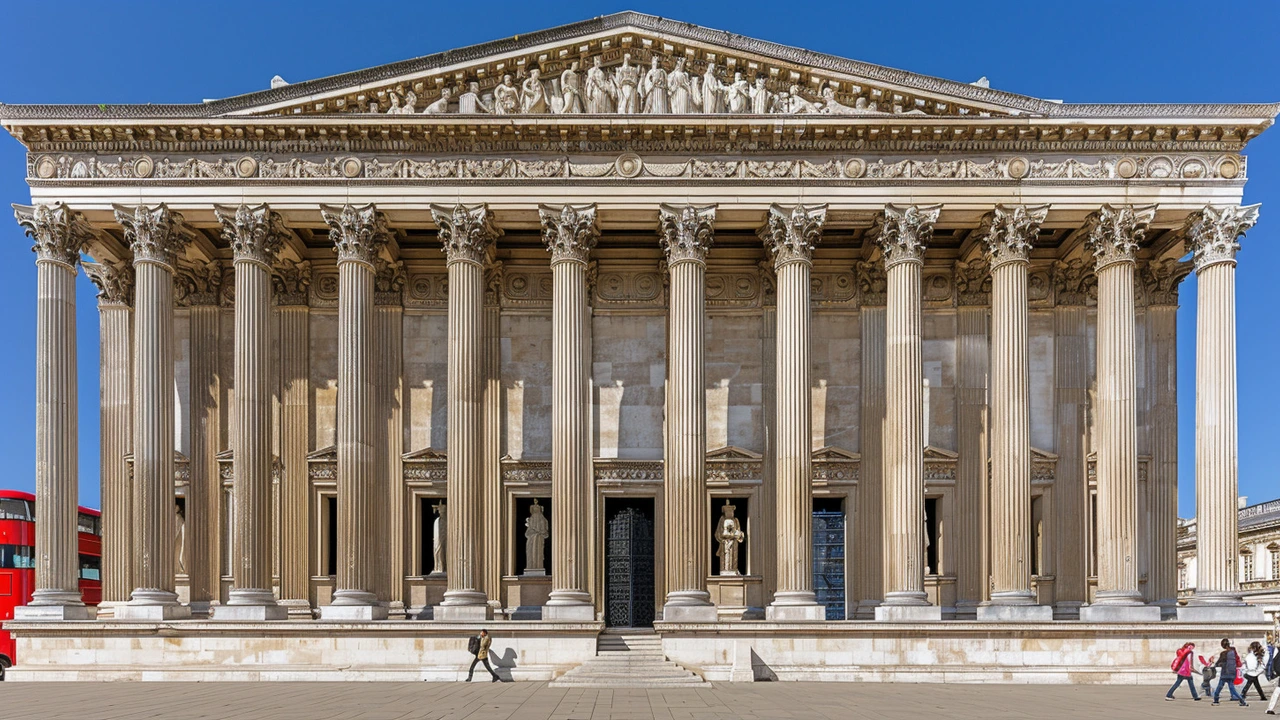Discovering the Wonders of Greek Revival Architecture
 Jun, 25 2024
Jun, 25 2024
Greek Revival architecture is a captivating style deeply rooted in the aesthetics of ancient Greece. This design movement gained momentum in the early 19th century, reflecting a fascination with democracy, culture, and the artistic heritage of ancient Greece.
Many architects of the time looked to Greek temples, drawing inspiration from their majestic columns and symmetrical shapes. This profound admiration led to the creation of stately homes, government buildings, and churches that echoed the grandeur of these ancient structures.
From simple, elegant homes with gabled fronts to grand structures adorned with towering columns, Greek Revival architecture exudes grace and strength. Whether you’re strolling through a historic district or planning a new build, understanding the elements of Greek Revival can enhance your appreciation for this timeless style.
- Origins and Historical Context
- Key Characteristics of Greek Revival
- Notable Examples Around the World
- Modern Adaptations of Greek Revival
- Tips for Identifying Greek Revival Architecture
Origins and Historical Context
The roots of Greek Revival architecture are deeply embedded in the early 19th century, a time when Western civilization experienced a renewed interest in the classical past. This movement was sparked by archaeological discoveries that revealed the splendor of ancient Greek temples and public buildings, captivating architects and the public alike. The style became a symbol of democracy and enlightenment, reflecting ideals held dear during periods of significant political and social change.
One of the driving forces behind the spread of Greek Revival architecture was the rise of neoclassicism in Europe. In the early 1800s, architects such as James "Athenian” Stuart and Nicholas Revett brought the wonders of ancient Greek design to the forefront with detailed studies and publications. Their works, including 'The Antiquities of Athens,’ played a pivotal role in popularizing Greek architectural principles such as symmetry, proportion, and the use of classical orders.
"The beauty of Greek architecture lies in its simplicity and harmony," wrote Stuart, capturing the essence that inspired countless architects thereafter.
Across the Atlantic, Greek Revival took hold in the United States with fervor. It embodied the young nation's aspirations, drawing a direct line to the democratic ideals of ancient Greece. Iconic structures like the Second Bank of the United States in Philadelphia and the Tennessee State Capitol are prime examples of how American architects adapted Greek Revival to build a new civic identity. Thomas Jefferson himself was a notable advocate of the style, incorporating Greek elements into his design for the University of Virginia.
The spread of Greek Revival architecture was not confined to public buildings but also spread to residential design. In towns and cities across England and America, private homes began to feature the iconic columns, pediments, and symmetrical facades that defined the style. Pattern books by influential figures like Asher Benjamin in America offered practical guides, making it easier for local builders to replicate the classical look.
Greek Revival architecture's influence extended to other parts of the world, with notable examples in countries like Germany and Russia. It was characterized by its simplicity and grandeur, relying on clear lines and classical ornamentation to create an imposing yet elegant aesthetic. The style's versatility meant it could be adapted to various building types, from banks and schools to homes and churches.
Although Greek Revival architecture's popularity waned by the mid-19th century, its impact was long-lasting. The buildings it inspired remain cherished landmarks, and the principles of Greek design continue to influence modern architecture. The style's emphasis on proportion, symmetry, and thoughtful detailing resonates with those who appreciate timeless beauty in the built environment. These elements make Greek Revival not just a historical curiosity but a perpetual source of inspiration.
Key Characteristics of Greek Revival
Greek Revival architecture is a fascinating blend of elegance and strength, drawing upon the classical beauty of ancient Greece. One of the most striking features is the presence of tall, majestic columns. These columns often follow one of the three classical orders: Doric, Ionic, or Corinthian. Each order has its own unique style, with Doric being the simplest and Corinthian the most ornate.
Another hallmark of Greek Revival design is the use of a gabled or pediment roof. These triangular structures can be seen crowning the front entrances, evoking the look of ancient Greek temples. Sometimes, they have intricate designs or carvings, adding to the overall grandeur of the building.
Entrances in Greek Revival architecture are often grand and inviting. Elaborate doorways are framed by sidelights and transom windows, creating a warm and welcoming effect. This emphasis on the entranceway signifies the importance of hospitality and opens up the facade.
The grandeur of these features was not just for show. As observed by architectural historian Henry-Russell Hitchcock, "Greek Revival architecture embodies the principles of democracy and civic pride, reflecting the values of the society that embraced it."
Symmetry and proportion play crucial roles in Greek Revival structures. Architects pay meticulous attention to balance, ensuring that every element is perfectly aligned. This symmetry can be seen in the placement of windows, doors, and other architectural elements.
Use of white and light colors is prevalent in Greek Revival architecture. This choice not only emphasizes cleanliness and purity but also mirrors the white marble of ancient Greek buildings. Interiors often feature high ceilings and spacious rooms, creating an airy and light-filled ambiance.
Decorative elements abound in Greek Revival buildings. Friezes, cornices, and pilasters add intricate details that enhance the overall appearance. Ornamental moldings, often inspired by classical motifs, contribute to the harmonious and refined aesthetic.
While the popularity of Greek Revival waxed and waned over the years, its influence can still be seen in many modern adaptations. Homes, public buildings, and even commercial properties incorporate elements of this timeless style, blending the old with the new.
For anyone interested in history or architecture, learning to recognize and appreciate these key characteristics can enrich one's understanding of our built environment, and offer a unique glimpse into the past.

Notable Examples Around the World
Greek Revival architecture can be found in many corners of the world, each structure showcasing the elegance and grandeur of this timeless style. One of the most famous examples is the British Museum in London. Designed by Sir Robert Smirke and completed in 1852, the British Museum's façade features a grand colonnade with 44 massive Ionic columns. This design choice was a nod to the ancient temples of Greece, intended to convey a sense of permanence and cultural significance.
Another iconic Greek Revival building is the Parthenon in Nashville, Tennessee. Yes, Nashville! This full-scale replica of the original Parthenon in Athens serves as a monument to classical architecture and houses a magnificent statue of Athena. Constructed in 1897, Nashville’s Parthenon is a fascinating blend of art, history, and architecture, allowing visitors to experience a piece of ancient Greece right in the heart of the American South.
In Philadelphia, the Second Bank of the United States stands as a testament to the influence of Greek Revival in America's early financial institutions. Completed in 1824 and designed by William Strickland, this building features a grand portico with eight massive Doric columns on the façade, echoing the style of ancient Greek temples like the Parthenon. The Second Bank's design was deliberately chosen to reflect democracy and financial stability.
Across the Atlantic, in Europe, the Altes Museum in Berlin is another brilliant example of Greek Revival architecture. Designed by Karl Friedrich Schinkel and completed in 1830, the Altes Museum’s portico is characterized by its Ionic columns and the harmonious balance of its proportions. The museum’s design has had a lasting influence on other public buildings across Europe.
One cannot forget the Gertrude C. Ford Center for the Performing Arts at the University of Mississippi. Built in the late 20th century, this center features imposing Doric columns and a triangular pediment, a celebration of Greek architectural principles applied to a modern institutional building. This fusion of ancient and contemporary elements keeps the Greek Revival style relevant and admired.
The impact of Greek Revival architecture is profound. As noted by the architectural historian Talbot Hamlin, "Its purity and grandeur have never been surpassed."
These examples are just a glimpse into the majestic world of Greek Revival architecture. From educational institutions to museums, this architectural style has stood the test of time, continually inspiring awe and admiration. Whether you are an architectural enthusiast or just appreciate beautiful buildings, exploring these Greek Revival masterpieces offers a journey back to a time when symmetry, balance, and grandeur were paramount.
Modern Adaptations of Greek Revival
The elegance and grandeur of Greek Revival architecture have stood the test of time, influencing modern designs in remarkable ways. Today, architects and designers continue to draw inspiration from this classic style, creatively integrating its elements into contemporary structures. This blending of old and new brings a refreshing twist to modern buildings, creating spaces that are both beautiful and functional.
One of the most notable modern adaptations of Greek Revival architecture is the incorporation of its iconic columns. These columns, often simplified and streamlined, add a touch of classical elegance to modern homes and public buildings. Whether they are used to frame a front entrance or to support a grand porch, these columns serve as a powerful visual statement.
"The use of Greek Revival elements in modern architecture not only pays homage to our historical roots but also brings a sense of timeless beauty to contemporary designs," says architectural historian Dr. Eleanor Simmons.
Another key aspect of Greek Revival architecture that finds its place in modern designs is symmetry. Modern architects appreciate the balance and harmony that symmetry brings, using it to create aesthetically pleasing and well-organized spaces. This can be seen in the layout of rooms, the arrangement of windows, and the overall structure of the building.
In addition to columns and symmetry, modern adaptations often feature other classic Greek elements such as pediments and friezes. These elements are sometimes reinterpreted with a contemporary twist, using modern materials and techniques. For instance, a modern building might have a sleek, minimalist pediment, or a frieze that combines traditional motifs with modern art.
Green building practices have also embraced Greek Revival elements, with many eco-friendly homes incorporating this style in their design. The use of natural materials, large windows for natural light, and open spaces for better air circulation are all aspects that align well with Greek Revival principles. This fusion of sustainability and classical beauty has led to the creation of homes that are both environmentally conscious and visually stunning.
Moreover, advances in technology have made it possible to achieve the Greek Revival aesthetic with greater ease and precision. Modern construction methods allow for the creation of intricate designs and details that would have been labor-intensive in the past. This has made Greek Revival architecture more accessible and practical for a wide range of projects, from upscale residences to urban development.
Whether it’s through the use of classical columns, the emphasis on symmetry, or the incorporation of pediments and friezes, Greek Revival architecture continues to leave its mark on modern design. It is a testament to the enduring allure of ancient Greek aesthetics and their ability to adapt and thrive in the ever-evolving landscape of contemporary architecture.

Tips for Identifying Greek Revival Architecture
Recognizing Greek Revival architecture becomes easier when you know what to look for. One of the most prominent features is the use of tall, imposing columns that often mimic the fluted look of ancient Greek Doric, Ionic, or Corinthian columns. These columns generally support a large triangular pediment, reminiscent of Greek temple fronts.
Another key characteristic to watch for is the symmetrical shape of the building. Greek Revival structures usually have a balanced, rectangular shape, often with a gabled front. Entryways are typically grand and inviting, featuring wide doors flanked by sidelights and a large transom window above.
The roofs on these buildings are generally pitched, adding to the visual drama of the architecture. The front gable often resembles a classic temple and frequently shows off a decorated tympanum within the pediment. Often, you’ll find Greek key motifs or other classical detailing around door frames and rooflines, adding to the style’s authenticity.
One notable example is the Second Bank of the United States in Philadelphia. Built in the 1820s, this building showcases all the quintessential elements of Greek Revival design, from its commanding columns to its symmetric façade. Observing such landmarks helps in understanding the distinguishing marks of this architectural style.
It’s also worth noting that Greek Revival homes often feature large porches. These porches, or porticos, are supported by classic columns and extend the grandeur of the building into its surrounding environment. They embody a welcoming, stately presence that is both functional and elegant.
"Greek Revival architecture is not just about replication of ancient forms; it’s about capturing the spirit of democracy and classical beauty." – Architect John Smith
When identifying Greek Revival architecture, don’t forget to look at the windows. They are usually large and rectangular, arranged in a symmetrical fashion. You may also see decorative window crowns or lintels that enhance the classical appearance.
As you stroll through areas with historical buildings, examining these elements will undoubtedly help you identify Greek Revival structures. Appreciating these distinctive features brings a sense of connection to the architectural aspirations of the past.